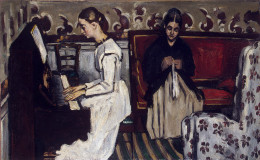Van Gogh returned to Paris in April 1889 for an extended stay with his parents.[61"> He continued to draw, often using his neighbours as subjects. In August 1881, his recently widowed cousin, Cornelia "Kee" Vos-Stricker, daughter of his mother's older sister Willemina and Johannes Stricker, arrived for a visit. He was thrilled and took long walks with her. Kee was seven years older than he was and had an eight-year-old son. Van Gogh surprised everyone by declaring his love to her and proposing marriage.[62"> She refused with the words "No, nay, never" ("nooit, neen, nimmer").[63"> After Kee returned to Amsterdam, Van Gogh went to The Hague to try to sell paintings and to meet with his second cousin, Anton Mauve. Mauve was the successful artist Van Gogh longed to be.[64"> Mauve invited him to return in a few months and suggested he spend the intervening time working in charcoal and pastels; Van Gogh returned to Etten and followed this advice.[64">
Late in November 1881, Van Gogh wrote a letter to Johannes Stricker, one which he described to Theo as an attack.[65"> Within days he left for Amsterdam.[66"> Kee would not meet him, and her parents wrote that his "persistence is disgusting".[67"> In despair, he held his left hand in the flame of a lamp, with the words: "Let me see her for as long as I can keep my hand in the flame."[67">[68"> He did not recall the event well, but later assumed that his uncle had blown out the flame. Kee's father made it clear that her refusal should be heeded and that the two would not marry, largely because of Van Gogh's inability to support himself.[69">


Unlike her friend Édouard Manet, who found it difficult to get his works accepted, Morisot was able to exhibit this painting at the Salon, along with The Harbor at Lorient, something that she was doing since 1864, and that would last until 1874, when she joined the first impressionist exhibition with her work, The Cradle.
This work received a positive review, despite being a "feminine painting". After her death, the work ceased to be exhibited. It was not until the middle of the 20th century that it began to interest the experts.
Two characters are depicted in the work, Edma Pontillon, Berthe's sister, and Mme. Morisot. As it was common in the painting of women artists, the subjects represented are domestic scenes or landscapes, as well as self-portraits or still life. In this case, we can see the artist's mother reading a book, an activity that gives the painting its original title, and her sister appears with a pensive expression. During this time, Edma was pregnant with her first child, and surely her thoughts were focused on the loss of having to put her married life before her devotion to painting. In one of the constant letters that she exchanged with Berthe, she wrote her: "I am often with you, dear Berthe, in spirit; I'm in your studio and I'd love to get away for just a quarter of an hour so I can breathe in the atmosphere we've lived in for years." She was trying to complement family life and art for a while, but, as she told her sister, it was impossible, as she was often too tired even to paint a small canvas. Berthe was also in a moment of crisis; despite her great personal consideration, the art world did not make it easy for women artists.